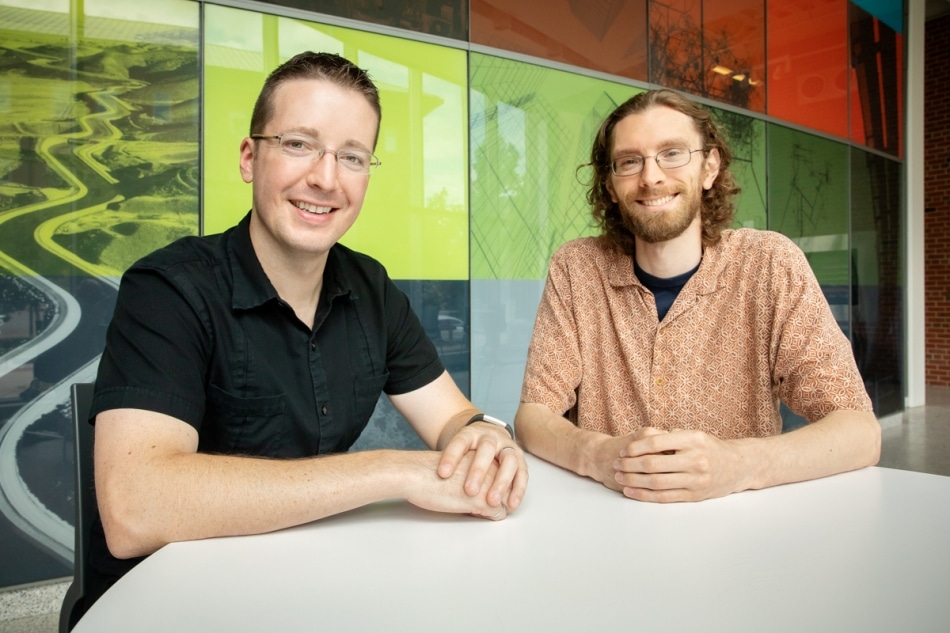Aug 20 2018
Although it may appear unpleasant to some people, human waste is full of nutrients that can be recycled into useful products, promoting better economic independence and agricultural sustainability for certain developing countries.
 Civil and environmental engineering professor Jeremy Guest, left, and graduate student John Trimmer evaluated the feasibility of using human-derived waste as a safe and valuable nutrient commodity. (Image credit: L. Brian Stauffer)
Civil and environmental engineering professor Jeremy Guest, left, and graduate student John Trimmer evaluated the feasibility of using human-derived waste as a safe and valuable nutrient commodity. (Image credit: L. Brian Stauffer)
Cities generate and have to manage large amounts of wastewater. Scientists from the University of Illinois at Urbana-Champaign have created a model to define the parts of the globe that might benefit the most from re-circulation of human-waste-derived potassium, nitrogen and phosphorus from cities and back into farm fields. The outcomes of the study have been published in the Nature Sustainability journal.
“We grow our crops in the field, apply nutrient-rich fertilizers, eat the crops, excrete all of the nitrogen, phosphorus and potassium and then those nutrients end up at the wastewater treatment plant,” stated Jeremy Guest, a civil and environmental engineering professor and co-author of the study. “It is a very linear, one-directional flow of resources. Engineering a more circular nutrient cycle would create opportunities that could benefit the environment, economy and agriculture.”
The exploratory study by the researchers involved the investigation of 56 of the largest cities across six continents in order to evaluate the possibility of recirculation of human-waste-derived nutrients. They took into account factors such as crop nutrient requirements transport population and cropland density, distance, and what kinds of products would be best and where.
“In some cases, wastewater that has been treated for safety can be used to simultaneously irrigate and fertilize crops,” stated John Trimmer, an Illinois graduate student and lead author of the study.
Treated wastewater is the best choice for places in which crops are grown close to cities, such as several parts of Asia, Africa, and Europe. Yet, it is difficult to transport water due to its weight and comparatively low nutrient content, hence it is not a wide choice when nutrients have to travel long distances to reach farmland, the researchers stated.
“In some cities, we would need to use more advanced technology to recover a more concentrated product suitable for longer transport distances,” stated Guest. “These are similar to the crystallized fertilizers that we are accustomed to and, in most cases, the technology to produce these from human waste is well established.”
The research demonstrated that a range of cities across the globe could benefit from this proposed sustainability strategy—not just for assisting in the growth of crops but also for their economic independence.
“We found, for example, that in Cairo, Egypt, if all of the nitrogen resources from wastewater were utilized, the city could cut Egypt’s nitrogen fertilizer imports by roughly half,” stated Trimmer. “This type of approach could also help smallholder farmers in places like Sub-Saharan Africa gain better access to fertilizer than what is currently available.”
The research also identifies parts of the world where the impact of nutrient recirculation may be lesser.
“Most of the population centers we looked at throughout the U.S. don’t appear to be the best candidates,” stated Trimmer. “For example, places like New York and Boston are too far from intense agriculture areas. However, the Midwest—Chicago in particular—did a bit better in our analysis.”
The researchers admitted to the fact that this type of exercise has its own downsides.
“Because this was developed as a global analysis, the method does not allow us to examine specifics for each city, like the driving routes to haul nutrients or locations of wastewater plants, among other details,” stated Guest. “The results of this exercise should be taken as estimates of nutrient transport distances, and are useful for identifying broad trends and locations that may warrant further investigation into reuse strategies.”
This study was supported by the Illinois Distinguished Fellowship at the University of Illinois at Urbana-Champaign.